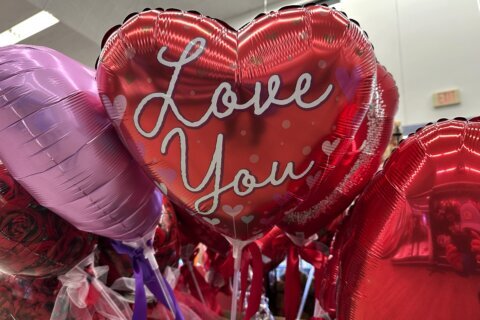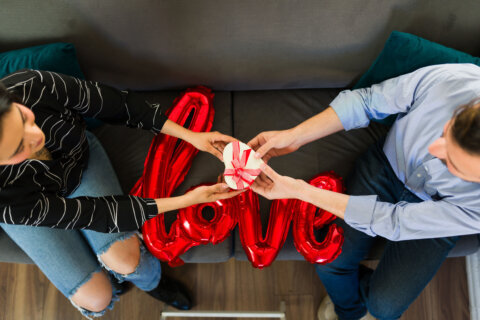To paraphrase Shakespeare, “A rose by any other name would smell as sweet,” but may cost a lot less on Valentine’s Day.
As the top-selling flower type for the Feb. 14 holiday, the rose’s increased demand and limited supply drive up costs throughout the industry, resulting in a higher market price for the consumer.
“The average number of roses produced for Valentine’s Day is roughly 198 million,” says Danny Mendoza, store manager of Sonny Alexander Flowers in Los Angeles. “The logistics of harvesting, processing, packaging and shipping that many roses in one week is staggering.”
What’s more, Valentine’s Day isn’t just an American holiday. “Believe it or not, [Valentine’s Day] is the only day that is the exact same worldwide,” says Callie Bladow, production director for BloomThat, a startup flower delivery service in San Francisco. “Even Mother’s Day falls on different days globally, so this in itself controls supply and demand much more than any other time of the year.”
These factors contribute to the 40 to 50 percent rise in wholesale pricing for roses, according to Laurel Ann Winzler, owner of Laurel Designs in San Francisco, with the highest cost attributed to a specific color. “[Wholesalers] charge a premium for red roses over all the other colors, and in fact all red flowers are at higher prices during this period,” she says.
Despite this understandable “Valentine’s Day tax,” Americans still plan to spend nearly $2 billion on flowers this Feb. 14, according to the National Retail Federation. And because Valentine’s Day falls on a Sunday this year, florists expect deliveries to peak twice — once on Friday, Feb. 12, and again on Valentine’s Day itself.
What can a star-crossed lover do to reduce flower costs without committing financial suicide? For one, choose any color of flower other than red. “A dozen red roses are typically $20 more than yellow, pink or orange roses,” says Kyle James, founder of deals site Rather-Be-Shopping.com.
James suggests including just a few roses in a bouquet of less-expensive varieties and skipping the vase offered by the florist, since you can find a better deal on containers elsewhere.
Winzler also likes the bouquet approach, advising customers opt for spring mixes for the most value. “For the same money that will get you a dozen roses, you can get a spectacular spring bouquet with colors and fragrances that roses don’t provide,” she says, adding that commercial roses don’t actually smell as sweet — or much at all — despite Shakespeare’s allusion.
Brittany Kinoshita, floral designer and owner of Hana Style Designs in Eaton, Colorado, suggests leaving the bouquet design up to the experts for the most value. “If you choose something that is ‘designer’s choice,’ you will usually get something nicer,” she says. “Most designers love to not have to follow a recipe, so they will often times choose nicer flowers so they can let their creativity flow.”
Another tip: Ask what flowers are on sale. “Sometimes a shop will order more of something as a ‘special,'” Kinoshita says. “It’s always best to ask this question when ordering.”
So what kinds of flowers can you expect when you request less expensive blooms? Alstroemeria, carnations, daisies, delphinium, larkspur and stock, to name a few. And don’t forget everyone’s favorite spring flower, the tulip. “It’s a sweetly romantic flower and has been growing in popularity as of late,” Mendoza says. “It looks fantastic when used in quantity by itself in arrangements.”
In addition to flower type, many consumers turn to the Internet for deals on flowers from such wire services as 1-800-Flowers, ProFlowers and Teleflora. Coupon codes abound for these providers, with many offering early-delivery deals of up to 25 percent off for those willing to spoil their Valentine as early as Feb. 10. To pull from Shakespeare again, “Better three hours too soon than a minute too late,” right?
Online promotions aren’t limited to the big wire services, however. Consumers interested in supporting sustainable farming can order an arrangement from The Bouqs Co., a flower delivery service that works directly with farmers in the U.S. and South America.
“We tend to have the best pricing because of our online nature and our direct sourcing model,” claims John Tabis, founder and CEO of The Bouqs Co. “One of the reasons we have year-round flat pricing is because we cut out all those layers and work directly with the farms.”
According to Tabis, bouquets (including one dozen red roses) sourced from South America start at a flat rate of $40, while next-day deliveries from U.S. farms start at $50. Delivery fees are waived for customers who create a free account with the site, and coupon codes are available for 10 to 25 percent off.
Prefer to support your local florist, but want the convenience of online ordering? Mendoza recommends BloomNation, an online platform — often referred to as the “Etsy for flowers” — which enables users to browse images of arrangements posted by florists located in the recipient’s ZIP code. “This combines online facilitation with a personal touch,” he says.
While flower type, early delivery and coupon codes will save you some money, there’s one surefire way to avoid Valentine’s Day markups entirely.
“My wife and I have found that saving money on Valentine’s Day flowers is actually pretty easy,” says blogger Nate Michaels of HackingYourBudget.com. “If you’re frugal, your Valentine’s Day should be February 15th instead,” he says. “Mark up on flowers? Gone.”
More from U.S. News
12 Shopping Tricks to Keep You Under Budget
10 Fun, Frugal Ways to Spend Your Free Time
How to Save Money on Valentine’s Day Flowers originally appeared on usnews.com







